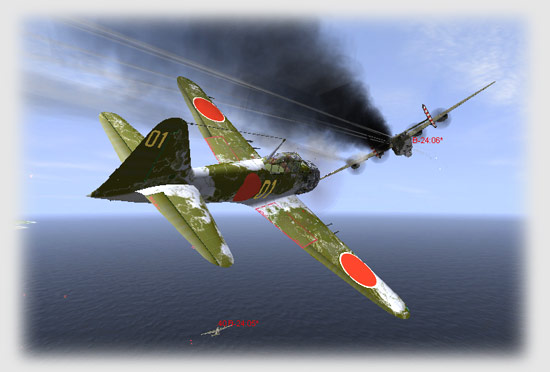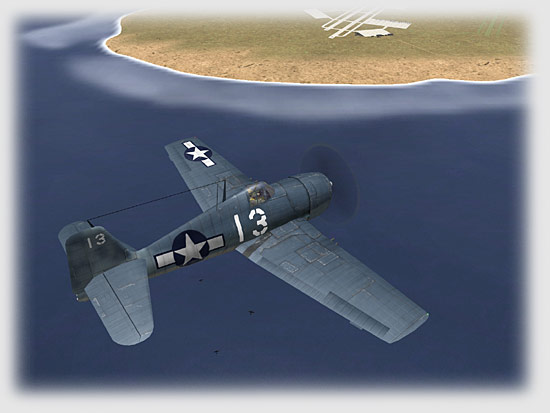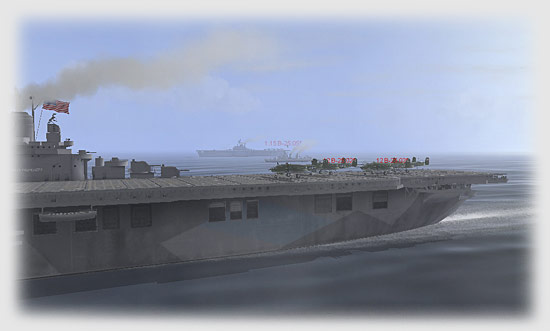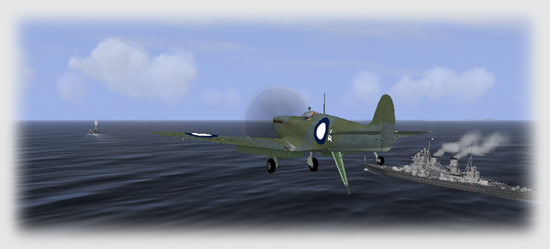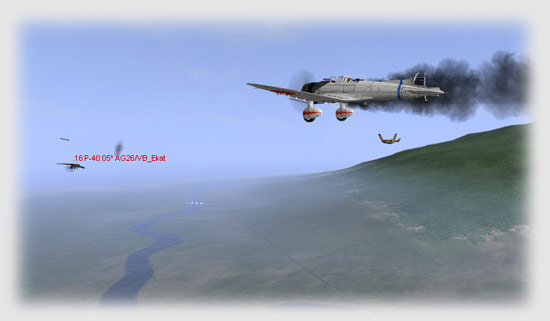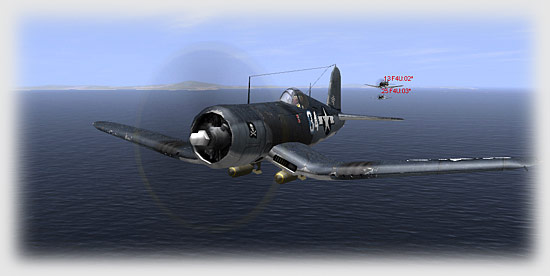Review
Pacific Fighters
Introduction
3 June 1942
Dear Diary,
Well, the higher ups are saying that soon we might come in contact with Japanese Forces. I know that judging from the work of the crew we might see some action very soon. It is hard to believe how much things have changed in just six months. We have been through so much as a crew, first the threats outside of Pearl Harbor, the narrow escape at Coral Sea, then the rapid repair and redeployment. This mission looks to be even deadlier than the one we faced near Port Moresby...
Oh for a really good Pacific Theatre flight simulator.
Let’s face it; there has been something of a vacuum when it comes to the Pacific Theatre. The last really, really good flight simulators that emulated the PACWAR was the venerable Aces of the Pacific and 1942 Pacific Air War. Both of these games significantly improved and advanced the genre. It is sad that these games were released in 1993 and 1994 respectively. Since that time there have been only a few games devoted to the Pacific Theatre.
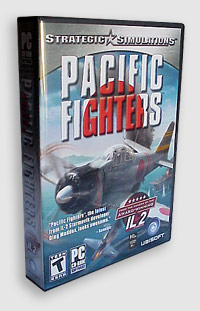 Some
had the Pacific added as part of a larger game. Air Warrior II and IIIs’
boxed sets had a Pacific Theatre setup that was playable, if not really
that inspired. EAW was modded to allow for Pacific dog fighting but the
engine really wasn’t totally up to the task. The only real PACWAR
flight simulator released since 1995 was Microsoft’s Combat Flight
Simulator 2, a game that did a lot really well but left a lot of things
to be desired. Sadly this game, although fun at times, just couldn’t
fill the void that was left after 1942 PAW.
Some
had the Pacific added as part of a larger game. Air Warrior II and IIIs’
boxed sets had a Pacific Theatre setup that was playable, if not really
that inspired. EAW was modded to allow for Pacific dog fighting but the
engine really wasn’t totally up to the task. The only real PACWAR
flight simulator released since 1995 was Microsoft’s Combat Flight
Simulator 2, a game that did a lot really well but left a lot of things
to be desired. Sadly this game, although fun at times, just couldn’t
fill the void that was left after 1942 PAW.
In 2001 a company called 1C games released a title called IL-2: Sturmovik, a title that received acclaim from critics and from consumers. Taking aim at the little seen Eastern Front and the seesaw battles that were fought on this relatively forgotten theatre (at least in the West) the game introduced so many new innovations and improvements to the genre that it is hailed as one of the most significant flight simulators ever produced.
Through the years the game engine showed its adaptability through various different upgrades, new versions and add-on packs. IL-2: Forgotten Battles introduced a dynamic campaign, many new aircraft and improved visuals. The Aces Expansion Pack furthered the westernization of the game, adding more western aircraft, more terrains and more features not seen in earlier versions.
Well, in what has to be the final utilization for the IL-2 engine, Oleg Maddox, Ilya Shevchenko and company have released Pacific Fighters, an either stand alone or companion game for IL-2: FB / AEP that attempts to finally fill that gap that has been missing in the Pacific Theatre. The game looks to add to the successes that IL-2 and Forgotten Battles have brought to the genre. Whether the game lives up to expectations is yet to be seen.
Installation and Setup
As sold, Pacific Fighters comes in the latest trend — the small size jewel case that is the rage these days. What is nice about this is the small storage size but what is bad, of course is the relatively small manual that comes with the game. Let’s face it, the day of the substantial manual is long gone and probably will never return. The manual for Pacific Fighters weighs in at a paltry seventy pages. In reality, this manual would be a quick start manual for one of the old Jane’s games from just four or five years ago.
I guess I might as well just deal with it, the days of the really good EAW or Longbow2 manuals are long gone. The manual that ships with the game is fairly informative and does show how to use some of the new features of the game. For its size it’s not bad, it just that it really is small and as an old flight sim snob I can’t get past that. I know it’s a cost saving thing — I just don’t like it.
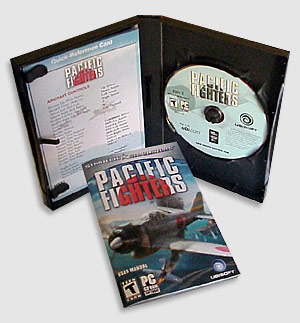 As
for the rest of the package you get two CDs, a key card and some discount
fliers for Alienware and for Naturalpoint. Naturalpoint offers a whopping
30 bucks off of its TrackIR3 head tracking device. Since the TrackIR is
a fantastic device for IL-2 (note: read SimHQ's TrackIR reviews here
and here)
it only seemed natural that Naturalpoint tied itself to Pacific Fighters
(PF). How it works with PF is yet to be seen though.
As
for the rest of the package you get two CDs, a key card and some discount
fliers for Alienware and for Naturalpoint. Naturalpoint offers a whopping
30 bucks off of its TrackIR3 head tracking device. Since the TrackIR is
a fantastic device for IL-2 (note: read SimHQ's TrackIR reviews here
and here)
it only seemed natural that Naturalpoint tied itself to Pacific Fighters
(PF). How it works with PF is yet to be seen though.
Setup is relatively simple and allows for two different kinds of setups for the game.
For those folks that already own Forgotten Battles and the Aces Expansion Pack, Pacific Fighters can be installed in conjunction with the older games to bring all the aircraft from Forgotten Battles and the Aces Expansion Pack into the Pacific Fighters game. Essentially this makes Pacific Fighters an expansion to the expansion to the Forgotten Battles game.
For those folks that don’t have Forgotten Battles and the Aces Expansion Pack, Pacific Fighters can be installed as a stand alone game. The stand along version is a fully functional game with all the features of the previous versions of the IL-2 series, but without the aircraft, campaigns or maps of the initial series. One problem with this dual setup is the incompatibility between IL-2:FB / AEP / PF and stand alone PF installations in online play. Basically if you play online you need to make sure that the people you play with are using the same kind of install of the game. Most folks with IL-2:FB and AEP tend to install both versions of the game to avoid any confusion.
Setup is pretty straight forward. The first time you fire-up the game you get the option to pick your graphics resolution, graphics mode (OpenGL vs. DirectX), basic graphic detail and whether you want the intro video to play each time you start the game. Most folks check this part off. The intro video — while interesting the first time you see it — isn’t worth repeated viewings.
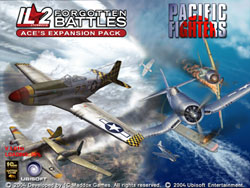 One
thing you have to setup — and one major complaint I have about the
game — are some of the key commands that really should have been
designated prior to release. Some functions, mostly those dating from
the release of IL-2:FB, are pre-mapped but many of the functions are user
defined and not mapped at all in the game. The ability to map functions
is good, don’t get me wrong. What was wrong is that some functions,
like releasing chocks on the flight deck, have to be mapped before you
can get off the aircraft carrier. This is explained in the manual but
it shouldn’t have been that difficult to designate a key press to
things like this prior to release. It isn’t a game stopper but it
is somewhat irritating.
One
thing you have to setup — and one major complaint I have about the
game — are some of the key commands that really should have been
designated prior to release. Some functions, mostly those dating from
the release of IL-2:FB, are pre-mapped but many of the functions are user
defined and not mapped at all in the game. The ability to map functions
is good, don’t get me wrong. What was wrong is that some functions,
like releasing chocks on the flight deck, have to be mapped before you
can get off the aircraft carrier. This is explained in the manual but
it shouldn’t have been that difficult to designate a key press to
things like this prior to release. It isn’t a game stopper but it
is somewhat irritating.
All the axes used my most HOTAS controllers are mappable in Pacific Fighters. Generally you can map trim for ailerons, rudder and tail controls, prop pitch and mixture levels in the game. Toe brakes aren’t modeled unfortunately so left and right brake controls are still mapped on the keyboard. Overall though the ability to map functions of the game are still quite good and anyone with complicated HOTAS controls should find a use for all their sliders and knobs. The nice thing about this game is that you really don’t need a complicated HOTAS controller to get the most out of this game, a simple Sidewinder is perfectly adequate for playing this game. Sure, if you have the cash for a nice CH Products or Thrustmaster setup won’t hurt — but it won’t put you at a major disadvantage if you don’t have it.
Sound and Graphics
When IL-2 was initially released it was considered a graphical marvel. The game brought so many new innovations to the game; things like custom skins, specific markings for individual aircraft, fantastic looking clouds and realistic looking terrain. The aircraft looked photo realistic, the cockpits better than anything ever created and the overall immersion in the game made the most realistic looking simulation to date.
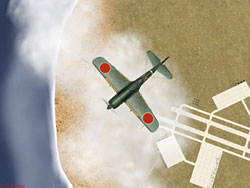 Forgotten
Battles and AEP improved somewhat on the graphics, taking more and more
advantage of the newer graphics cards being produced but overall the looks
of the game remained similar to the original game. Pacific Fighters continues
the look — which is good and bad. The game still looks pretty decent
overall and is comparable to most of the newer engines that have been
released. It isn’t quite as good as LOMAC or CFS3 (in some respects)
but it still looks good and gives some other newer sims a run for its
money.
Forgotten
Battles and AEP improved somewhat on the graphics, taking more and more
advantage of the newer graphics cards being produced but overall the looks
of the game remained similar to the original game. Pacific Fighters continues
the look — which is good and bad. The game still looks pretty decent
overall and is comparable to most of the newer engines that have been
released. It isn’t quite as good as LOMAC or CFS3 (in some respects)
but it still looks good and gives some other newer sims a run for its
money.
That doesn’t mean that the game engine hasn’t started to show some wrinkles. The game looks pretty good at medium angles and isn’t too bad down low but the weakness of the graphics engine, and the thing that was exposed in AEP was the high altitude look of the game. IL-2 was never really designed to simulate high altitude fighting and in Pacific Fighters the limitations, at least graphically, show. The sky and terrain at twenty thousand feet look more like fifty thousand feet. Some of this is the limited ability to draw long distance terrain.
Aircraft continue to look excellent and border
on photo realistic. There are games that render aircraft with more polys
but I still have yet to find a game that renders aircraft in a better
manner. The aircraft just ‘feel’ real. The details of the aircraft
continue to be amazing. The differences between models of the F4F are
detailed in the game. The renderings of the cockpits are just as good.
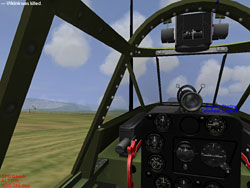 Many
of the cockpits were created by private individuals for use in the game
but unless you have followed the game from start to completion you would
be hard pressed to figure out which ones were made by whom.
Many
of the cockpits were created by private individuals for use in the game
but unless you have followed the game from start to completion you would
be hard pressed to figure out which ones were made by whom.
The terrain looks pretty much like IL-2:AEP with a few graphics tweaks and additions that bring it to the Pacific. While in general the terrain looks good and works to maintain immersion, the buildings in the game fail to thrill me like they did a couple of years ago. Don’t get me wrong, the game still looks good and flying down low still gives you that sense of speed and altitude that is essential for a good air-to-ground combat simulation. Unfortunately, when you compare it to games like LOMAC some of the buildings and terrain effects look dated. This isn’t a slam, it was an eventuality that the game would lose its cutting edge looks. It still looks good, it just doesn’t look as awe inspiring as it used to.
 Water
effects continue to shine in the game. For folks with the latest NVIDIA
graphics cards, the water effects are simply amazing. For the rest of
us, you get decent looking water effects. Radeon 9800 Pro owners can get
a dll to install in the PF directory (or IL-2 depending on install) which
adds some of the water effects that NVIDIA players enjoy. It doesn’t
look quite as good but is passable and enjoyable.
Water
effects continue to shine in the game. For folks with the latest NVIDIA
graphics cards, the water effects are simply amazing. For the rest of
us, you get decent looking water effects. Radeon 9800 Pro owners can get
a dll to install in the PF directory (or IL-2 depending on install) which
adds some of the water effects that NVIDIA players enjoy. It doesn’t
look quite as good but is passable and enjoyable.
Overall I have to say that graphically this is about as good as it gets for the IL-2 series. While the engine shows its age, a little at least, it still is as good as any simulation released in the last two years and still better than most.
One thing to note with the game is that it continues to look fairly decent on medium to medium high end machines. A player with a Pentium 4 1.5 GHz and a GeForce Ti4600 will get very respectable performance out of the game. Guys with the latest hardware, i.e. the GeForce 6800 Ultra series, the latest Pentium 4 processors and the max amount of RAM will be able to max it out. At its maximum resolutions and graphics settings, the game looks outstanding. At lower settings it still looks good. Graphically you can’t ask for much more than Pacific Fighters delivers.
Gameplay
A game can look good but if it plays poorly, it isn’t worth a damn.
One of the reasons that the IL-2 series has been as successful as it has is due to the cutting edge flight and damage models that shipped with the original game. Pacific Fighters is just as top notch, although there are some questions and some concerns — especially with the AI.
Pacific Fighters ships with almost all of the most common aircraft found in the Pacific Theatre. Not all, but most. There are many familiar names, aircraft that were made famous over the skies near Midway and Guadalcanal. There are others, somewhat ignored, that worked their way into the game.
The Allies get the opportunity to fly a representation of some of the greatest warplanes ever created. Aircraft include the three variants of the venerable F4F Wildcat, two models of the F6F Hellcat, two variants of the SBD Dauntless, and four variants of the F4U Corsair (actually seven if you include the Royal Navy subtypes that were used aboard their carriers). The Brits get a Seafire for its carrier task forces as well as the Bristol Beaufighter Mk 21. The USAAF gets a flyable B-25J and A-20G.
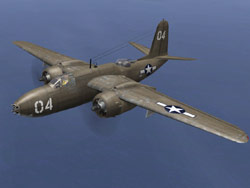 |
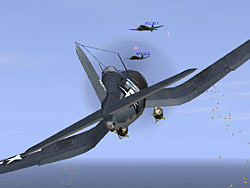 |
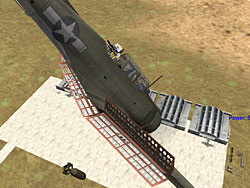 |
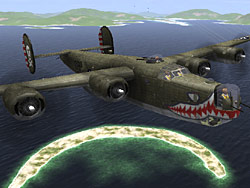 |
The Japanese get to fly the cream of Japanese Army and Naval Aviation. The A6M Zeke (Zero), introduced in the a5 version in an add-on in the Aces Expansion Pack, gets many more variants to include the type 21 version of the A6Ma2 (folding wingtips), a3 and a7 variants. The Ki 43, considered the most maneuverable monoplane fighter of the war, enters the fray. The Ki 84, 61, and 46 are in the game. The J2M3 Raiden, and aircraft that I have never seen in a flight sim, is in the game. The D3A Val makes its appearance in the game for those folks that want to do some dive bombing.
 |
 |
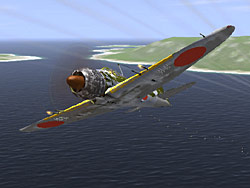 |
 |
The most interesting is a float plane version
of the A6M, a slow maneuverable aircraft that actually performs well in
the game. Why it performs well will be discussed in a minute. In general
you get almost a perfect representation of the aircraft that took part
in the major battles of 1942 and 1943. Why do I say almost? Well, notable
in their absence are the TBF Avenger and the B5N Kate as flyable in the
game. The TBD Devastator wasn’t even included in the Initial release
of the game although there are plans to add it soon... well, maybe not.
There looks like a snag with any inclusion of aircraft from Northrop Grumman.
This means that any new aircraft, like unfortunately the TBF Avenger,
may not make it into the game. What this means for the Kate or for the
Devastator is unknown at this time.
I hate to say this, but the lack of flyable carrier born torpedo bombers has to be one of the biggest disappointments I have in this game. I can understand the potential difficulty in finding cockpit data for the Kate or data in general about the Devastator, but there are dozens of flyable TBF and Ms models in existence. There is nothing more knuckle whitening than trying to take a slow predictable path at an enemy capital ship so you can launch your torpedoes. Its not that torpedoes aren’t modeled in the game. Both the IL-2 He111 and Beaufighter carry torpedoes in the game.
Another thing missing are some of the more common ships seen in the game. Some of the more famous carriers are in the game, such as the Lexington class. Actually the Lexington and Saratoga are both represented in the game, although the model of the "Lady Lex" modeled is a pre-war configuration (with 8 inch guns, not the customary dual use 5 inchers common to carriers during the war). The Essex class is represented as well, but interestingly the Yorktown class is not present in the game. The Japanese have the Kaga and Akagi but there are none of the smaller CVLs that really pulled yeoman’s service during the war.
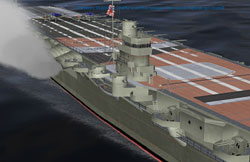 More
interestingly is the lack of almost all of the major capital ships that
were part of the Pacific. I don’t expect every single battleship
or cruiser class to be represented in the game but there are no U.S. battleships
or IJN battlewagons — only the King George V class dreadnoughts are
in the game. In addition there are no British destroyers or cruisers,
no IJN heavy cruisers and only the USS Indianapolis (a Northampton class
if I remember correctly) is represented as a heavy cruiser in the game.
More
interestingly is the lack of almost all of the major capital ships that
were part of the Pacific. I don’t expect every single battleship
or cruiser class to be represented in the game but there are no U.S. battleships
or IJN battlewagons — only the King George V class dreadnoughts are
in the game. In addition there are no British destroyers or cruisers,
no IJN heavy cruisers and only the USS Indianapolis (a Northampton class
if I remember correctly) is represented as a heavy cruiser in the game.
If you have a full FB / AEP / PF install you can add some of the earlier warships like the Tirpitz and several Russian heavy cruisers and destroyers. This helps but for those of us that thrive on immersion, I really would have liked to see some of real ships that took part in these battles. A Pearl Harbor scenario with a bunch of King George V battleships just doesn’t look right. Attacking the Yamato is impossible in the game. There should have at a minimum been two types of IJN battleships, two types of U.S. battleships (more for a credible Pearl Harbor scenario), several cruisers and the Yorktown class carriers. It’s a gripe, but IMHO, a major one.
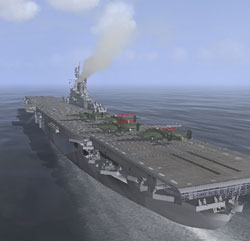 I
know there are reasons as to why some of these ships and some of the aircraft
didn’t make it into the game — but they are excuses. This is
a Pacific Theatre, Second World War game and these ships and these aircraft
should be in the game. I slammed CFS2 for some of the same things so I
can do nothing less than make some of the same critiques of Pacific Fighters.
I
know there are reasons as to why some of these ships and some of the aircraft
didn’t make it into the game — but they are excuses. This is
a Pacific Theatre, Second World War game and these ships and these aircraft
should be in the game. I slammed CFS2 for some of the same things so I
can do nothing less than make some of the same critiques of Pacific Fighters.
Ok, enough negative. One of the more positive things about Pacific Fighters are the flight models and the way the aircraft fly in the game. The flight models aren’t perfect, there are some areas to gripe but the 3.01 patch brings the game up to a higher level and makes for a very enjoyable, and IMHO realistic game.
Carrier use is a new feature of Pacific Fighters and I can’t think of a more ingenious way of maintaining the feasibility of carrier operations. One of hardest things to figure out had to be what to do with aircraft that land on the carriers. AI was easy, you just have them de-spawn after landing but online play was a little more difficult. By applying chocks after landing you make your plane essentially invisible, or in reality you remove the ability to hit the aircraft. This way an entire squadron can land on an aircraft carrier without the difficulties of making usable elevators or despawning out of the game completely.
Taking off from a carrier is probably easier than it should be. In CFS2 I spent a lot of time trying to keep my aircraft on the ship but in Pacific Fighters the takeoffs seem to be a whole lot easier. Once I lock my tail wheel and throttle up I generally take it straight off the carrier. Now if I firewall it I tank it, but a gradual increase in throttle tends to lead to a generally straight takeoff. That doesn’t mean that taking off with every aircraft is easy. A fully loaded F4U can be very hard to get off any carrier, especially the smaller escort variety that come with the game. The key is dropping flaps and bringing up power quickly but smoothly.
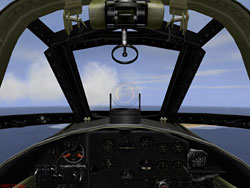 Landing
is a little bit harder. Hitting a moving target with your aircraft requires
more than a little bit of practice. I have had some experience with Warbirds,
CFS2 and Aces High but to me this feels like the most realistic of all
the landing programs. Unlike CFS2 there is no LSO to guide you in but
in all honesty I never used the LSO to begin with. The F4F and the Zeke
have the ability to raise the seat, a very nice feature for those trying
to see over the nose of their aircraft. You can’t do this in other
planes, including the F4U. What would be nice is the ability to move yourself
around in the cockpit, ala Aces High, especially when lining up a difficult
trap.
Landing
is a little bit harder. Hitting a moving target with your aircraft requires
more than a little bit of practice. I have had some experience with Warbirds,
CFS2 and Aces High but to me this feels like the most realistic of all
the landing programs. Unlike CFS2 there is no LSO to guide you in but
in all honesty I never used the LSO to begin with. The F4F and the Zeke
have the ability to raise the seat, a very nice feature for those trying
to see over the nose of their aircraft. You can’t do this in other
planes, including the F4U. What would be nice is the ability to move yourself
around in the cockpit, ala Aces High, especially when lining up a difficult
trap.
Which brings up the TrackIR3 Pro and its latest feature: "6 degrees of Freedom" support. Microsoft has embraced the technology, importing it into FS 2004 and into CFS2 (which didn’t originally have TIR support). Essentially, TrackIR3 Pro owners now have the ability to not only move their head on the left right axis but also to the front/back and to the sides. Oleg decided that the cockpit graphics may not look quite so hot with this feature and has declined to update Pacific Fighters to take advantage of this technology. He may change his mind later, who knows. Right now the TrackIR works fine in its "2DOF" mode and it is just as good in Pacific Fighters as it is in the rest of the IL-2 series.
I would have liked to see this feature in Pacific Fighters. The IL-2 series has always been a cutting edge sim when it comes to new hardware but I won’t get too wrapped around the axle. I know Oleg wants to devote most of his time to his next sim and every time he goes back to the IL-2 series he has to delay working on Battle of Britain.

The AI also tends to be suspect at times. The AI ranges from being out-and-out brilliant to out-and-out stupid at other times. This really has been an ongoing problem with the IL-2 engine and the difficulties with the AI are really shown in this latest version of the game. The AI, especially the friendly AI tends to do some really bone headed maneuvering in the game.
What exposes this is the philosophical differences between the two major combatants in the Pacific Theatre. The Japanese tended to build light, quick, extremely maneuverable aircraft like the A6M series and the KI 43 series. The U.S. decided to go with more heavily armed, armored and faster aircraft like the P-38, F6F and F4U. In low speed turning dogfights the Japanese pilots would tend to have an advantage over the higher horsepower — but more sluggish — U.S. mounts.
This is where the problem arises. The AI in the
game tries to dogfight with every fighter in the game. This wasn’t
so bad when it was a Bf 109F against and Yak1 but when you take an F4U-1
against an A6Ma5 you run into a serious mismatch. In the real world, the
U.S. pilots figured out right away not to turnfight with the nimble Zekes
but in Pacific Fighters the U.S. pilots never seemed to learn that. 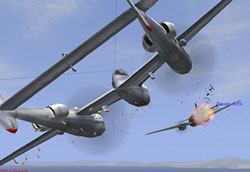 Even
ace level pilots try to get into turn fights which often means a lot of
shot down buddies. It really is a reality crusher for me when I take a
flight of eight P-38s against eight Zekes and I come back with myself
and maybe another guy while only one or two A6Ms go down.
Even
ace level pilots try to get into turn fights which often means a lot of
shot down buddies. It really is a reality crusher for me when I take a
flight of eight P-38s against eight Zekes and I come back with myself
and maybe another guy while only one or two A6Ms go down.
Some AI improvements have been addressed. The ship AI is now configurable to allow for a varying amounts and accuracy of ack when you attack. In the past, attacking shipping was virtual suicide, but now you can configure the game to keep yourself alive during your dive bombing run. Likewise, ground and enemy aircraft gunners are less laser like and you actually have a better chance of attacking and defeating the enemy. Saddling up on a bomber’s six will get you shot down quickly but slashing attacks actually work now.
Campaign and Single Missions
If you are familiar with the IL-2: Forgotten Battles setup then you will be very familiar with the setup for the single missions, the campaigns and the mission builder of Pacific Fighters. Since PF is essentially an upgraded and improved Forgotten Battles engine, the setup is identical.
The game comes with a variety of single missions based upon the nationality and the type of fighter or bomber you accept. While the total number of missions that you can play with Pacific Fighters is probably adequate (over 30 single mission types with PF alone) unfortunately there is a feel that single missions are somewhat tacked on. Most of the missions are based upon a nationality and a fighter / bomber type and there are generally four or five missions that you can fly with each of these types. Like Forgotten Battles, players have the opportunity to add custom skins to their aircraft for use in the game.
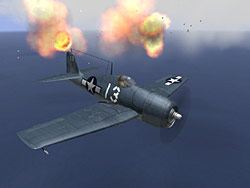 The
missions range from training style missions (carrier training mostly)
to intercept and attack missions that highlight the aircraft modeled.
Most of the missions are well crafted and highlight the strength of the
mission builder. Probably the most helpful missions are the training missions,
especially for those folk that have little experience landing on a virtual
aircraft carrier. Others are fun but most people will find them less than
thrilling.
The
missions range from training style missions (carrier training mostly)
to intercept and attack missions that highlight the aircraft modeled.
Most of the missions are well crafted and highlight the strength of the
mission builder. Probably the most helpful missions are the training missions,
especially for those folk that have little experience landing on a virtual
aircraft carrier. Others are fun but most people will find them less than
thrilling.
In reality this has been a problem with not just Pacific Fighters, but with most recent flight sims in general. It has been a trend lately to minimize the shipped number of single missions in a game, relying instead on the public to create single missions that fill that void. In the case of IL-2: Forgotten Battles and Pacific Fighters this really is a mistake. There was a major chance to create some of the major fights of the Second World War with PF. I would love to have had a single mission where I flew a Hellcat during the Marianas Turkey Shoot or as an SBD attacking the Japanese Carriers at Midway.
While these missions are being created by individuals independently and either are now or will be soon available for download, the essential problem still remains. Since probably fifty percent of the buyers of the game rarely download even patches for a game it is unlikely that many will bother to look for add-on missions. In addition, many newbies getting into the game probably will be turned off by the relative lack of missions for the game. While the veterans of the series may not have a problem looking for or creating missions, I fear that newbies may not have the patience that the rest of us have.
Ok, enough of that. One of the best features of the entire IL-2 series has been its quick mission builder and the mission builder of Pacific Fighters hasn’t messed with the winning formula. Quick missions can be made with all the flyable in Pacific Fighters and if you have the IL-2:FB and Aces Expansion Pack on board you can take up well over 80 different fighters or bombers in the game. You can set up fighter vs. fighter combat, escort missions, bombing missions, with up to 16 different aircraft flying against each other. Pilot experience, ordinance and numbers of aircraft are all scalable in the game.
One new thing for Pacific Fighters is the ability to set up missions using PF aircraft in ship attack missions. You have the capability of defending your carrier or attacking enemy warships with your Val. A quick mission can be set up and be up and flying less than one minute with the quick mission builder. Like Forgotten Battles you have the ability to add custom skins to your flyable as well as to the AI aircraft in the game. I have found that this is the best way to get into a quick fight is to use the quick mission builder.

The biggest part of the game is of course the dynamic campaign that ships with Pacific Fighters. Similar to the one from Forgotten Battles the campaign allows players the opportunity to play as a major combatant forces for either the Allies or Imperial Japan. Allied forces include campaigns based upon the U.S. Navy, Marine Corps, and USAAF. The British get Royal Navy missions and the Australians get RAAF missions where the Beaufighter gets to bare its teeth. The Japanese aren’t ignored either as several different campaigns for the Imperial Japanese Navy and Army are available.
The campaigns range from USN actions starting
at the Battle of the Coral Sea to Marine Corps actions at Guadalcanal.
The campaign that shipped with the packaged version mistakenly had the
P-39 listed as the aircraft of use in the Guadalcanal campaign but this
has been corrected in the recent patch. Likewise some new campaigns were
created starting with Wake Atoll for the Marines. Don’t plan on living
very long if you start with that one. IJN campaigns can have you taking
off from carriers for the IJN or flying a Rufe covering Guadalcanal, KI
43s and Ki 61s for the IJA. 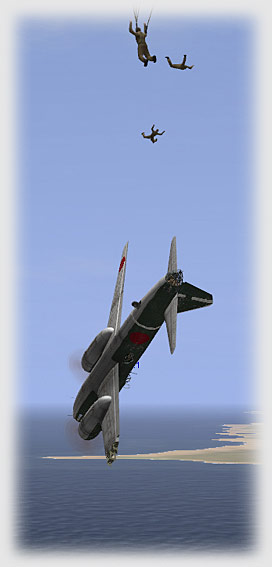 Most
of the careers can be started from the point of most of the major battles
of the Pacific Campaign. If you want to jump into an F6F right away? No
problem, start out in 1943 on the USS Essex. Want to bomb Pearl Harbor?
Not a problem, jump into a Val at the beginning of the war.
Most
of the careers can be started from the point of most of the major battles
of the Pacific Campaign. If you want to jump into an F6F right away? No
problem, start out in 1943 on the USS Essex. Want to bomb Pearl Harbor?
Not a problem, jump into a Val at the beginning of the war.
The campaigns are fun as a general rule but like many dynamic campaigns you have some repetition of missions. In fact, with many of these missions, you will find yourself flying around a lot while shooting at very little. Many recon missions are part of the game. While interesting and realistic there are some complaints about how some of the campaigns are, well, boring. You will spend a lot of time crossing long distances in this game. This isn’t Crimson Skies, this is supposed to be a recreation of the air war over the Pacific and overall long boring flights were the norm of the Pacific War.
Like Forgotten Battles, the campaigns progress logically through the war while at the same time the generator keeps two campaigns from ever being exactly the same. In addition, scripted campaigns are playable in the game. I haven’t progressed far enough to see if I can actually influence history but I am of the assumption that the Allies will, of course, win. You can start a campaign as a lowly pilot right out of training or you can assume a role of squadron commander if you want total control of your forces.
I highly recommend that you start out with higher ranks in the campaign. One of the problems that I have with the campaign is the AI’s fixation with things. This is a problem with most flight sim AIs and without the power to call them back to finish the mission you may find yourself going after that carrier alone or trying to defend those Kates with just your Zero. The AI will fixate on fighting what is right there many times and will leave the bombers as easy prey for other fighters if not kept in check.
Of course, the mission builder for Pacific Fighters is the same top notch one that dates all the way back to the first IL-2. With this builder you can create missions that run the gamut from reality to totally fanciful. If you have IL-2:FB and AEP installed with Pacific Fighters you have the capability to create some very interesting missions. Have you ever wanted to fly off an escort carrier in support of Operation Torch? Well, with the builder you have the opportunity to create a mission just like that. Want to pretend the USS Lexington was there to help sink the Bismark? It is possible with the builder. No, not all the correct maps are present but a little imagination can help fix that.
 Missions
can be as complicated or as easy as you want. The mission builder isn’t
exactly as intuitive as I probably would have liked but it is pretty powerful
and most folks get the hang of it in a few short hours. The manual, as
small as it is, does cover mission building pretty well. Missions can
be created for both offline and online games. Mission packs specifically
designed for multiplayer coop or squad vs. squad action are constantly
being created for IL-2:FB and it is assumed that there will be many made
using Pacific Fighters as well.
Missions
can be as complicated or as easy as you want. The mission builder isn’t
exactly as intuitive as I probably would have liked but it is pretty powerful
and most folks get the hang of it in a few short hours. The manual, as
small as it is, does cover mission building pretty well. Missions can
be created for both offline and online games. Mission packs specifically
designed for multiplayer coop or squad vs. squad action are constantly
being created for IL-2:FB and it is assumed that there will be many made
using Pacific Fighters as well.
Overall the single mission, campaign and mission builder is essentially the same as the ones that shipped with IL-2: Forgotten Battles. While some may complain that for a full title there should be something different I personally feel that the mission builder and campaign engine were certainly as good as most already and that tinkering with it too much would probably not be that great an idea. The only major complaint that I had with the offline stuff is the relative lack of single player missions. It would have been nice if the beta testers could have been convinced to submit missions to add to the release copy. I understand the lack of space already on the two CDs that shipped with the game but there should be more offline single missions in the game. Overall it is a minor gripe from someone that downloads a ton of stuff for the game (missions, campaigns, campaign generators, single mission generators, skins) but newbies may be put off by the sparcity of some of the single missions.
Multiplayer Mayhem
These days you can’t have a top notch sim without a decent multiplayer code. One of the highlights of the IL-2 series has been its multiplayer engine, a robust vehicle that has kept the game alive for years. While other, newer games have come and gone, the IL-2 engine has continued to thrive in places like Ubi.com and Hyperlobby. Pacific Fighters continues upon the solid multiplayer of its predecessors and even manages to improve a little upon the originals.
The original IL-2 boasted 32 person (non-ai) multiplayer capability, an impressive number back in 2001. Indeed, many modern games are lucky to get 16 people playing at the same time. Forgotten Battles upped the number of head-to-head fighters to 64 and coop (i.e. with some AI aircraft) players to 32. Pacific Fighters raised the bar again, this time claiming the ability to host up to 128 fliers at one time. This takes the multiplayer from the realm of a box sim with online capability to the potential of being the first box simulation that could seriously compete against the online only games like Warbirds and Aces High.
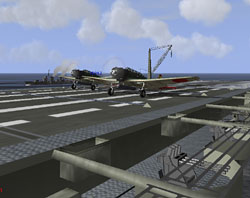 To
be honest, at the time of this writing I have yet to actually see, much
less fly in, a true 128 player match. While theoretically possible I have
the feeling that the computing power needed for such a setup would be
too much for the average gamer. There may be someone with a spare server
lying around that could host a game like that but there aren’t too
many of us around with that kind of hardware power and bandwidth to spare.
Even games over 32 players tend to get warpy at times.
To
be honest, at the time of this writing I have yet to actually see, much
less fly in, a true 128 player match. While theoretically possible I have
the feeling that the computing power needed for such a setup would be
too much for the average gamer. There may be someone with a spare server
lying around that could host a game like that but there aren’t too
many of us around with that kind of hardware power and bandwidth to spare.
Even games over 32 players tend to get warpy at times.
A lot of this depends on the connection of the players, that is for sure, but a lot of it is due to the limitations of current technology. Even if the software allows the capability to fly in 128 player arenas the power of the average PC with a standard cable or DSL connection probably still isn’t up to par with such lofty dreams. Dedicated games like Fighter Ace 3.5 still have the luxury of being able to host large numbers of fliers with little lag.
This may change with the upcoming server that Ubi is planning on putting out with its patch. The details of the server are a little sketchy but if it allows 128 people the opportunity to fly in a lag free environment then I predict that games like Warbirds may have a more threatened future. Lag free 128 player servers would allow people the opportunity to really create battles like the Coral Sea or Midway. I can foresee players signing up for special events recreating the Solomons campaign or the air combat around Guadalcanal. If you add the capability to play with Forgotten Battles and AEP then the special events could become quite interesting.
There are some problems with the multiplayer. Most of them are small, some are legacy problems with the original IL-2 series. I have found that the game can still be quite laggy with more than five or six fliers in a coop game. This is made worse if one or two people have dial-up connections with higher ping times. Always make sure the fastest connect is the one that hosts. I have logged into games where I am the faster player and at times I have had trouble with everyone warping on me. I personally won’t log into a game hosted by a dial-up person, under any circumstances.
One other problem is the incompatibility of stand alone Pacific Fighters to fly with games containing both PF and IL-2:FB+AEP. It can get somewhat confusing for people who own both series to figure out who is flying what in the game. Log into Hyperlobby and you may find that your AEP / PF game may not run with someone who is using just AEP or with someone who just has Pacific Fighters on their computer. Ubi.com just has a lobby for those with Pacific Fighters. There may be some folks who would like to fly P-47s against Ki 61s. Those guys are out of luck at Ubi.com. It is confusing and probably will be for a while. I am hoping that Jiri at Hyperlobby can come up with a separate lobby for IL-2:FB fliers, IL-2:FB / PF fliers and PF standalone pilots. It doesn’t have to be separate lobbies, just separate rooms in the IL-2:FB lobby for those that have different versions of the game.
So overall the multiplayer has improved slightly but there is no significant improvement over the prior versions of the game. It remains to be seen as to how the dedicated server UBI is putting together will work. Of course, the biggest improvement is the ability to wage a carrier war online against your buddies. For many of us, this is a significant improvement. I do think though that the only way to play this game is online. Online campaigns can and are being generated and the difficulties that I have found with the AI offline is mitigated by flying with real live humans. If your buddy tries turnfighting in his Corsair and gets his butt shot off then he has no one to blame but himself.
Overall Opinions and Recommendations
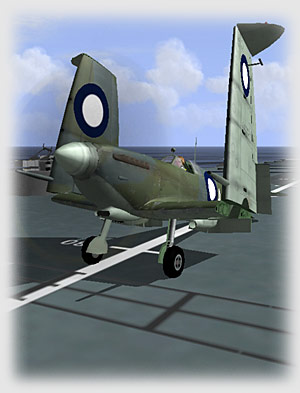 This
may seem to be a relatively hard assessment of Pacific Fighters. In some
respects the game is receiving much greater scrutiny because it is essentially
the third major version of the game since the initial game was released.
This means that the problems that were not noticed with the first version
of IL-2 or Forgotten Battles are now much more apparent. This doesn’t
take away from what is in reality a fine combat simulation and a very
good game overall. It just means that greater expose means greater scrutiny.
This
may seem to be a relatively hard assessment of Pacific Fighters. In some
respects the game is receiving much greater scrutiny because it is essentially
the third major version of the game since the initial game was released.
This means that the problems that were not noticed with the first version
of IL-2 or Forgotten Battles are now much more apparent. This doesn’t
take away from what is in reality a fine combat simulation and a very
good game overall. It just means that greater expose means greater scrutiny.
The game is solid, well made and overall gives the player exactly what he or she wants from a Pacific War simulation. The graphics continue to impress me, even after all these years. In addition the flight models are in general right on the money and the damage models seemed to reflect the relative strengths and weaknesses of the types of aircraft flown in the game. The online environment is only rivaled by the dedicated online only flight simulations and this game isn’t too far behind them. If I have ever had any problem with the series it is that it tries to do too much for too many people. It is amazing that this game has progressed from the study sim of the IL-2: Sturmovik to the survey simulation that it has become.
All complaints aside, and there are several out there, this game is by far the best Pacific War flight simulation ever made. The first time you line up a dusk approach on the USS Essex you will agree with me.
Test System Specs
- Dell Dimension
4600
- Pentium 4, 2.8
GHz (HT)
- 1GB 400MHz DDR
RAM
- 80 GB Ultra ATA
100 HD
- Radeon 9800 Pro
(Note: Some images taken with an ATI X800 XT)
- Creative Audigy 2 sound card
- Broadband cable connection for online play
Copyright 2008, SimHQ.com. All Rights Reserved. Contact the webmaster.
